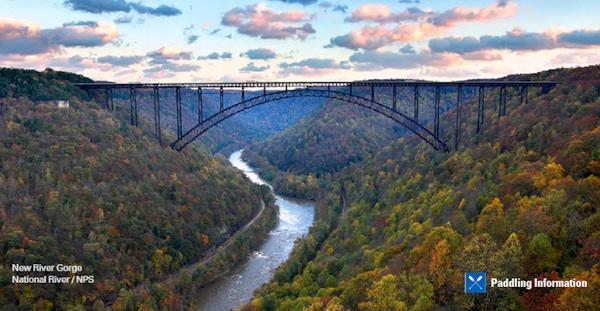I gave my heart to the mountains the minute I stood beside this river with its spray in my face and watched it thunder into foam, smooth to green glass over sunken rocks, shatter to foam again. I was fascinated by how it sped by and yet was always there; its roar shook both the earth and me. ' Wallace Stegner

Rivers run fast and tumbling throughout the National Park System, there are streams with lazy meanders, and placid lakes perfect for dipping a paddle. This diversity poses a delightful dilemma when you have the urge to float and paddle. What follows is just a sampling of the experiences that await you, whether you have hundreds of watery miles under your paddle, or are looking for calm waters to take your youngsters. Where available, links take you to paddling information specific to the park unit.
Eastern Parks
Paddling information: http://www.nps.gov/neri/planyourvisit/whitewater.htm
Despite its name, the New River really is one of the oldest rivers in the world, which is just an interesting tidbit, not the main draw, for paddlers. Rather, it's the succession of rapids that range from playful riffles to demanding Class V waters that draw white water enthusiasts from throughout the East.
The New, around which New River Gorge National River arose in 1978, cuts its boulder-strewn course north from North Carolina through the deepest and longest canyon cut by a river through the Appalachian Range.
The national river includes 53 miles of the New, running from the Bluestone Dam and emptying into Hawks Nest Lake. But it's the lower section (on the northern end) that attracts the most attention from paddlers. Here rapids named Upper and Lower Railroad, Double Z, and Greyhound test your skills. The season runs throughout the spring and summer.
Paddling information: http://www.nps.gov/gari/planyourvisit/whitewater.htm
The Gauley, sister of the New River, was added to the National Park System a decade later, as a national recreation area. Unlike the New, the peak season for running the 25 miles of the Gauley River that lie within the NRA begins the weekend after Labor Day and runs for six consecutive weekends as water is released from the Summersville Dam to push river runners down 25 miles of chutes, sluices, and rock mazes that generate white-water bearing VI+ ratings.
Creating this incredible challenge is the fact that the riverbed drops more than 650 feet along the way downstream, while ledges and rock fields create more than 100 rapids -- Iron Ring, Shipwreck, and Lost Paddle, just to name three -- worthy of your attention.
Captain John Smith Chesapeake National Historic Trail
Spanning nearly 3,000 miles throughout the Chesapeake Bay, this historic trail offers more than a few places to dip your paddle, whether it's used to propel a canoe or sea kayak.
Pick up a copy of A Boater's Guide to the Captain John Smith Chesapeake National Historic Trail and you'll find out where you can paddle, locate launch sites, and receive a primer on Captain Smith's early 17th century explorations of the bay.
Under an innovative agreement with the National Oceanic and Atmospheric Administration, a network of 'talking' buoys has been anchored in the bay. Paddlers calling a toll-free number -- 877-BUOY BAY -- can receive information ranging from the latest weather forecast to recordings that interpret points along the water trail.
Cape Cod National Seashore, Massachusetts
Though most visitors to Cape Cod National Seashore head to the beach, there are some surprising paddling opportunities here. While the Atlantic Ocean pounds away at the eastern face of this national seashore, venture inland and you'll find some nice ponds and marshy areas to paddle, and, if you go far enough, even the calmer waters of Cape Cod Bay.
The park's salt marshes and estuaries can be perfect for paddlers if you time the tides right, lather up with sunscreen and wear a wide-brimmed hat, and avoid the buggiest parts of the day (daybreak and sunset).
The national seashore's rangers can help you enjoy some of these waters, as during the high summer season they lead canoe trips near Eastham on Salt Pond and nearby Nauset Marsh as well as on Long Pond on the west end of Provincetown.
Kettle ponds elsewhere on the cape, such as Long or Seymour ponds near Brewster, Cliff Pond in Nickerson State Park, are perfect for canoeing, while Little Pleasant Bay and Salt Pond Bay are great for sea kayaks.
Next Wednesday: Paddling Southern Parks

 Support Essential Coverage of Essential Places
Support Essential Coverage of Essential Places







Add comment